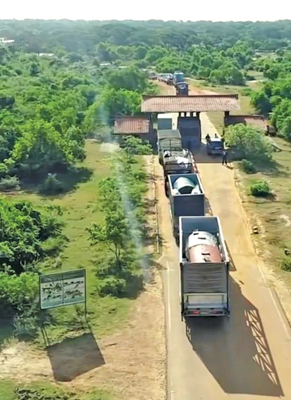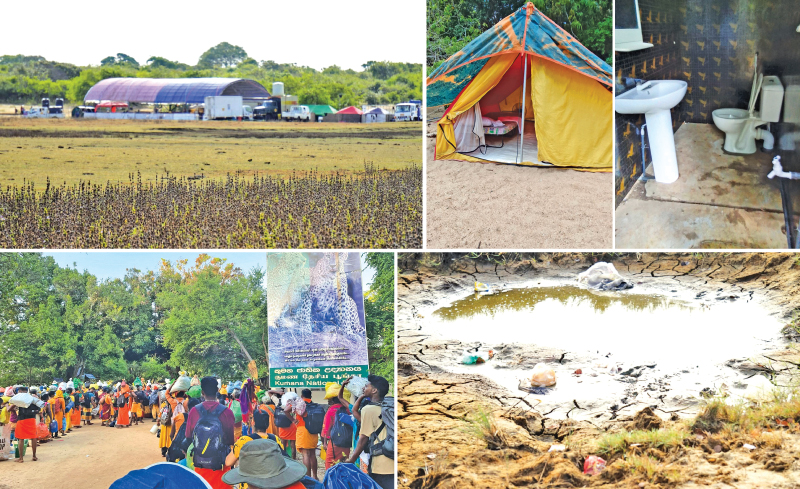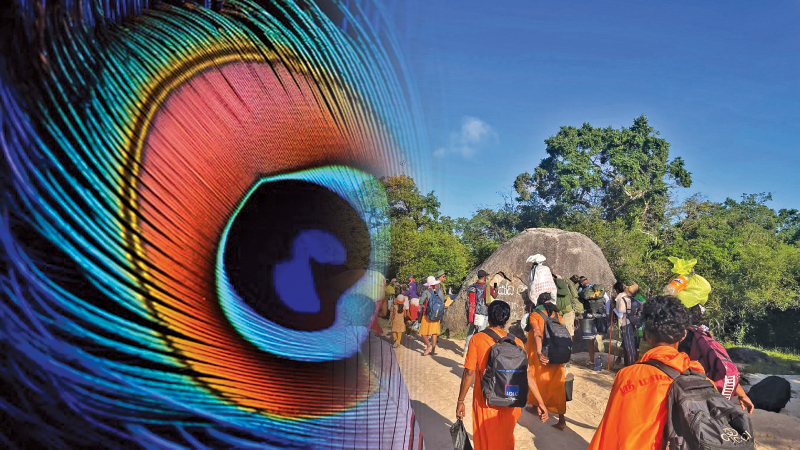In July 2024, this writer first reported that the traditional Hindu pilgrimage known as the ‘Kataragama Pada Yatra’ which traces a sacred route from Jaffna to the Kataragama temple was emerging as a serious threat to the ecological integrity of the Yala and Kumana National Parks.
Once a spiritual journey, the walk has increasingly become a marker of religious and cultural identity, drawing large crowds and institutional involvement. Our investigation highlighted several pressing concerns: the overwhelming public turnout, the growing role of the Navy, unruly conduct at dansalas and, most notably, the Department of Wildlife Conservation’s failure to adequately monitor the pilgrimage route. Disappointingly, a year later, little has changed. Beyond a limited effort to regulate plastic and polythene waste, it appears the authorities have again overlooked the broader environmental and administrative issues previously raised.
The Pada Yatra offers an exceptionally rare opportunity to traverse Sri Lanka’s national parks—most notably Yala and Kumana on foot, without a ticket or permit. Under normal circumstances, entering or exiting Yala National Park from any point requires special authorisation from the Director General of Wildlife, and strict regulations apply, especially within Zone Two of the park. However, the pilgrimage bypasses these controls, creating a loophole that has increasingly attracted various groups seeking to exploit the route for their own narrow interests, under the guise of religious and cultural tradition.
Environmental impact
 Among those exploiting the loophole are so-called environmentalists, wildlife photographers, and adventure tourists. As a result, the original religious and cultural significance of the Kataragama Pada Yatra has been diluted, while the ecological sanctity of the wildlife reserves is steadily being eroded. Alarmingly, even the security forces, dansalas, and various Government institutions entering Yala and Kumana during the pilgrimage are engaging in activities that violate the Flora and Fauna Protection Ordinance. This represents a deeply troubling and serious situation that demands immediate attention.
Among those exploiting the loophole are so-called environmentalists, wildlife photographers, and adventure tourists. As a result, the original religious and cultural significance of the Kataragama Pada Yatra has been diluted, while the ecological sanctity of the wildlife reserves is steadily being eroded. Alarmingly, even the security forces, dansalas, and various Government institutions entering Yala and Kumana during the pilgrimage are engaging in activities that violate the Flora and Fauna Protection Ordinance. This represents a deeply troubling and serious situation that demands immediate attention.
This year, again, the gates of Kumana National Park were opened on June 20 to accommodate pilgrims from across the island taking part in the Pada Yatra. Since the end of the war, the annual number of participants has ranged between 25,000 and 30,000. In 2024, this figure reached a record high of 31,986. Traditionally, Hindu devotees undertook this journey with deep reverence, causing minimal environmental impact. However, as we previously reported, the pilgrimage has since been co-opted by various external actors, transforming what was once a low-impact spiritual journey into a large-scale event with significant environmental consequences.
The current Director General of Wildlife supported earlier findings, acknowledging to the media that “the influx of participants requiring added facilities such as bottled water and health services, along with the involvement of the military, has significantly altered the nature of the pilgrimage and its impact on wildlife.”
Delicate ecosystem
Despite this official recognition, there is still no indication that either the Ministry of Environment or the Department of Wildlife Conservation has taken any meaningful steps to mitigate the ongoing environmental damage caused by these activities.
Again this year, the Sri Lanka Navy has also entered the national park during the pilgrimage season to provide water to pilgrims. But serious allegations have emerged that a large contingent of military personnel entered Yala National Park under the pretext of offering security and logistical support to visiting Navy officials. Their presence, however, has reportedly caused significant harm to the park’s delicate ecosystem.
These harmful activities include driving vehicles through the park at all hours, clearing forested areas to construct temporary facilities such as toilets and showers, and straying beyond the designated pilgrimage route into protected zones, actions that directly threaten the integrity and conservation of the national park.
Despite mounting pressures, the Department of Wildlife Conservation has made efforts this year and last year to prevent vehicles from entering Yala National Park ahead of the official time through the Palatupana entrance. However, Navy vehicles often arrive early in the morning and wait, allowing them to be the first to enter once the gates open. As their convoy moves through the forest, it inevitably disturbs the local wildlife, including elephants, tigers, and bears—causing these animals to flee. Consequently, both local and foreign tourists who have travelled long distances, stayed overnight in Tissamaharama, and entered the park early to observe abundant wildlife are often left disappointed and return empty-handed.
Reports from the past two years reveal that a naval chief and his security detail, travelling on foot, have arbitrarily entered Yala National Park’s official tourist route via the Thalgasmankada area, diverting from the path designated for pilgrims. Such actions are detrimental to the wildlife and the tourism industry. Moreover, the tents and toilet facilities constructed within the park this year suggest that these same disruptive issues are likely to recur.
During the pilgrimage season, numerous Government and private sector groups, as well as people, enter the protected area claiming to organise dansalas (alms-giving stalls). Among them are the previously mentioned so-called environmentalists and wildlife photographers, along with others who arrive under the pretext of conducting health camps. These groups have been accused of driving Defender vehicles through the park at night, using powerful spotlights that disturb and stress the wildlife. Such activities pose a serious threat to wildlife conservation and are deeply concerning.
A loophole
Tourists who enter national parks after paying the fees and obtaining proper permits are strictly allowed to travel within the park only between 6 a.m. and 6 p.m. Yet, it is deeply troubling that various groups exploiting the pilgrimage season use permissions granted by the Department of Wildlife Conservation as a loophole to flout conservation laws, operating beyond these regulated hours. Notably, last year dansala organised at the Parana Thotupola Tourist Bungalow in Yala Zone One was accused of travelling day and night to Katupilara and beyond, where the dansala is maintained. Despite these concerns, the Department of Wildlife Conservation has again granted permission for this dansala this year.
Even after the war ended, for many years, pilgrims undertaking the Pada Yatra did not depend on anyone’s dansalas for support. However, their presence has now contributed to a steady increase in the number of participants each year.
Except in a few instances, tourists visiting Sri Lanka’s national parks are always accompanied by a tour guide provided by the Department of Wildlife Conservation, or at least by safari jeep drivers accountable to the Department—though this system is not without criticism. However, for nearly two weeks during the pilgrimage season, tens of thousands of outsiders have been moving freely within Zones One and Two of Kumana and Yala National Parks without any such supervision. This makes it crucial for the Department of Wildlife Conservation to implement strict monitoring measures. The unregulated activities we have highlighted such as driving Defender vehicles at night with powerful spotlights that disturb wildlife, and the use of drones for filming clearly demonstrate that such oversight is currently lacking.
The prolonged presence of large crowds in wildlife reserves has profound environmental consequences, including disrupting the natural behaviour of animals and contaminating ecosystems and water sources with waste and excrement. As the number of participants grows, so too does the environmental impact. The transformation of the Kataragama foot pilgrimage from a solemn, challenging journey into a large-scale festival threatens to further increase tourist numbers and amplify this damage.
Therefore, it is crucial that all levels of wildlife conservation management from the Director General of Wildlife to the authorities overseeing the Yala and Kumana National Parks exercise greater caution and responsibility when issuing permits. The Government must also ensure adequate infrastructure and deploy sufficient wildlife officers to rigorously monitor human activities, swiftly address emerging issues, and enforce necessary measures without hesitation.
It is the collective duty of all Government and private sector stakeholders—including Government officials and religious leaders not to exploit this ancient pilgrimage for short-term gain or entertainment, to avoid misusing public funds on fraudulent ventures tied to it, and to act responsibly in safeguarding wildlife. Above all, this pilgrimage must not become a pretext for disregarding environmental laws and endangering Sri Lanka’s precious natural heritage.
The writer is a researcher, environmental activist, freelance journalist, and Ph.D. candidate at the College of Forestry, Guangxi University, China.








